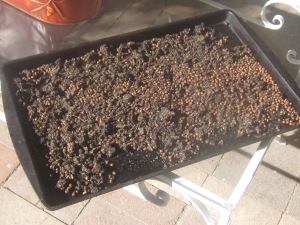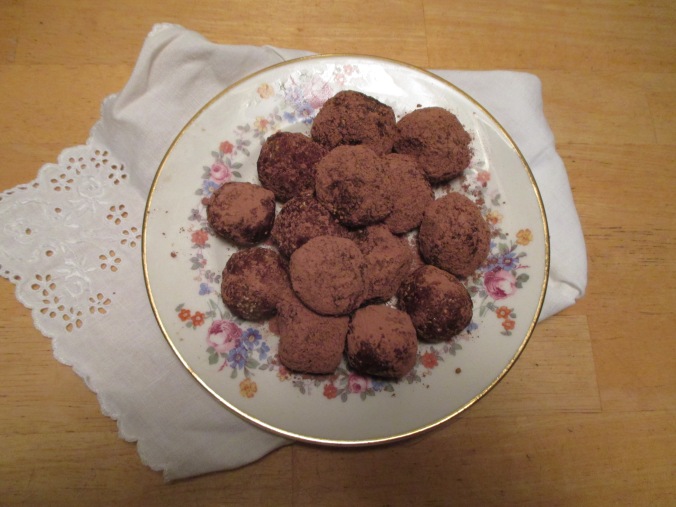It’s Carolyn this week, taking you backstage to a food experiment. As we move into a hotter, drier climate here in the Southwest, we’ll have to consider agricultural products that can handle the changes. Although I’ve been playing with edible wild plants for decades and Tia Marta (Muffin Burgess) has put in similar years of work, it’s always exciting for us to find something new. We’re going to do a two-part investigation of what to do with a wild food new to both of us.
Last fall I received an email from noted ethnobotanist Dr.Richard Felger. He and a colleague, Dr. Don Hodel, an environmental horticulturist for the University of California Cooperative Extension, were working on some wild palm fruits, two species of Washingtonia, also called Mexican or California fan palm. He wondered if I could come up with some recipes. Back in the early 1970s when I was just beginning work with wild edibles, Dr. Felger took me on one of my first plant walks and over the years has answered many questions for me. I figured I owed him. I also asked Tia Marta if she wanted to join in the fun.
After a couple of days, FedX deposited a box with about 10 pounds of tiny hard black nodules on my doorstep – Washingtonia robusta fruit gathered from a park in Signal Hill, Calif. , near Long Beach. Not promising, they were little more than skin on seed with almost nonexistent flesh, nothing like their cousins the palm fruits we know as dates. Humans have a long history of using palm fruits – in fact some scholars think that the honey referenced in the Bible was actually date syrup.
Wendy Hodgson, THE expert on wild desert foods, says in her book Food Plants of the Sonoran Desert, that the Washingtonia fruits were very important to the Cahuilla and Cocopa. She writes, “They made flour from the ground dried fruits and mixed it with other flours and water to form a mush.” We don’t eat much mush anymore (unless you consider oatmeal for breakfast), so I’d have to devise something else to do with them.
I took 4 cups of fruit and covered them with 8 cups of water. Brought it all it to a boil, then simmered uncovered for 30 minutes. I ran the softened fruit through a blender in batches and strained the liquid, ending up with 5 cups of almost black liquid that tasted something like prune juice.
. I simmered it until reduced to ¾ cup pulpy liquid then spread the remaining pulp and seeds on a cookie sheet and put it in sun to dry. Later, I sifted out ¼ cup dried flakes and discarded the hard seeds.
At this point I wrote Dr. Felger my scientific assessment: Sweet — but definitely not yummy. I pressed on and made some tasty muffins. Since there is interest in natural sweeteners, I concentrated on that aspect. Using a standard muffin recipe, I substituted the palm syrup for the liquid milk and reduced the sugar. I added the dried flakes just because I had them and to add some texture.
Fan Palm Muffins
Makes 1 dozen
1 ¾ cup unbleached white flour
¾ teaspoon salt
2 teaspoons baking powder
2 tablespoons sugar
¼ cup dry powdered milk
¼ cup dried Washingtonia flakes
2 eggs
¾ cup pulpy Washingtonia syrup
3 tablespoons melted butter
Mix dry ingredients in a bowl. In another bowl, mix eggs, Washingtonia syrup and melted butter. Stir wet ingredients into dry ingredients. Do not overmix; some lumps are OK. Bake in greased muffin tins at 400 degrees F for about 15 minutes or until they appear done.
Meanwhile, Dr. Hodel acquired some Washingtonia filifera fruit from a street tree near Indio, Calif., and sent another 10 pounds. Oh boy. They were still tiny, but bigger than the robusta. I put them through a similar process of simmering, blending, straining and reducing. The taste difference was subtle – more date-like than prune-like. Better.
I decided to use the filifera syrup in a healthy treat, showcasing its natural sweetness, and came up with these truffles. I used almond butter, but other nut butters will do.
Nutty Truffles
Makes 1 dozen
½ cup almond butter
½ cup popped amaranth grain
¼ cup ground popped amaranth
6 tablespoons Washingtonia filifera palm syrup
1/3 cup cocoa or carob powder
Combine all ingredients except cocoa in a bowl and blend with a spoon. Form into 12 small balls. Roll each in cocoa. (You can buy popped amanranth at Native Seeds SEARCH)
♥ ♦ ♥ ♦
What’s the point of trying to find a way to use the fan palm fruits? With climate change bringing hotter, drier summers to the Southwest, ethnobotanists like Dr. Felger and Dr. Hodel are looking for plants that can take those conditions and still produce food.
I don’t expect a rush of people heading out to gather bushel baskets of fan palm fruits. They’ll appeal to the more ardent wild food enthusiasts who, like me, want to taste every berry on every bush. But they may have uses in more industrialized food production. They are sweet and easy to harvest and process. Some entrepreneur may see opportunity there. After all, nobody I know makes their own agave syrup.
(Check out Dr. Richard Felger ‘s article at “Arizona Native Food Plants for a Dry Future” in The Plant Press: The Arizona Native Plant Society vol. 37, no. 2: 1, 3-5.)







Pingback: Palm Tree Fruit - Travel To Eat
Just when the filifera seeds are ripe but before the dry out, the liquid in the dehusked fruit smells like honey. I have’nt dried its taste though. Is it eadible.
LikeLike
What about jams or jellies? Maybe even wine?
LikeLike
Jams, jellies, wine – any of those might be possible if you took the time to fiddle with some recipes. Let us know if you come up with something wonderful!
LikeLike
Truffles – Great idea!
LikeLike
I do have a traditional historic metate (a gift from a friend collected long long ago when that was legal). But, I confess, I just couldn’t face the work it would take.
LikeLike
PS: The web link somehow disappeared: http://eattheweeds.com/forum/index.php?topic=90.0
LikeLike
Since Washingtonia is also naturalized in Florida, I looked on Green Deane’s “Eat the Weeds” Florida-based Wild Foods webpage. Nothing in the plant archive, but the forum offered this:
Washingtonia filifera, CALIFORNIA FAN PALM —
“ripe fruit (fall, winter), raw or dried; seeds ground for meal; young leaf base, raw or cooked”
Maybe the leave bases taste any better? (I am more of a savory food type of person myself; not that much into muffins nor cakes, nor do I have much need for sweeteners, so I will try the leaves sometime)
LikeLike
Interesting. I had lots of seeds but nothing appropriate to grind them with. The two researchers have hired someone to do a nutritional analysis and it is currently in process. Hodgson in writing about historic uses in the Sonoran desert doesn’t mention leaves. Please let us know how it works out. I’m sure Felger and Hodel would be interested.
LikeLike
Maybe pounding the hard seeds in a bedrock mortar (“cupule”), or lacking that, grinding them in a molcajete/traditional Mexican basalt mortar would possibly be able to crack them into some sort of “seed meal”? Could also test the feasibility of a traditional use of the seeds… Supposedly prickly pear seeds were ground into flour traditionally and they are plenty hard as well. (I have seen small trough-shaped metates used for cocoa beans and corn, but they are probably soft in comparison to palm seeds)
Hmm, will try at home and also ask some Middle Eastern and African friends if they know of any uses of diff. palm seeds, or if they were just throw away (I thought African palm oil but it is made from the oily pulp of a different palm/Elaeis guineensis instead).
LikeLike